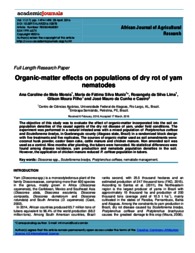Organic-matter effects on populations of dry rot of yam nematodes.
Organic-matter effects on populations of dry rot of yam nematodes.
Author(s): MORAES, A. C. de M.; MUNIZ, M. de F. S.; LIMA, R. da S.; MOURA FILHO, G.; CASTRO, J. M. da C. e
Summary: The objective of this study was to evaluate the effect of organic-matter incorporated in to the soil on population densities of the causal agents of the dry rot disease of yam, under field conditions. The experiment was performed in a natural infested area with a mixed population of Pratylenchus coffeae and Scutellonema bradys , in Quebr angulo county (Alagoas state, Brazil) in a randomized block design with five treatments and five replicates. The sources of organic matter used as soil amendments were: coconut husk powder, castor bean cake, cattle manure and chicken manure. Non amended soil was used as a control. Nine months after planting, the tubers were harvested. No statistical differences were found among disease incidence, yam production and nematode population densities in the soil. However, the application of chicken manure reduced P. coffeae population in tubers.
Publication year: 2016
Types of publication: Journal article
Unit: Embrapa Semi-arid Region
Observation
Some of Embrapa's publications are published as ePub files. To read them, use or download one of the following free software options to your computer or mobile device. Android: Google Play Books; IOS: iBooks; Windows and Linux: Calibre.
Access other publications
Access the Agricultural Research Database (BDPA) to consult Embrapa's full library collection and records.
Visit Embrapa Bookstore to purchase books and other publications sold by Embrapa.

